You’ve probably felt that moment of panic. Your horse comes in from the field with a squinty, red, tearing, swollen eye. Immediately, your mind races to the worst-case scenario as you dial your vet. Will your horse end up losing his eye?
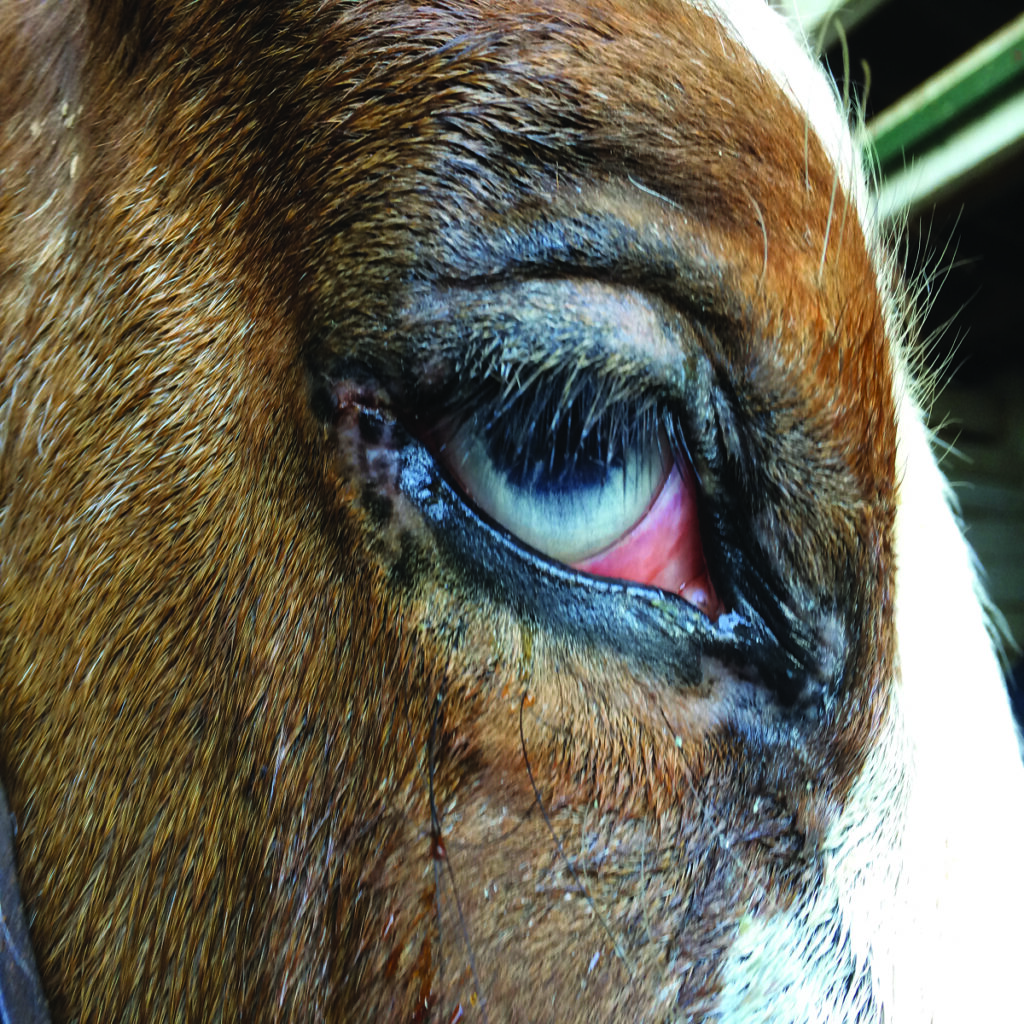
When Your Horse Gets an Eye Ulcer
The cornea is the outside cellular layer of the front of the eyeball, which acts as a protective barrier. A scratch or rub to the cornea damages these cell layers. Superficial scratches may only damage the outer layer, called the epithelium. Deeper injuries affect the middle layer, which is called the stroma.
Extremely deep scratches or punctures can reach the very bottom layer, called Descemet’s membrane. This is the last layer of the cornea before the inner structures of the eyeball are breached and the eye ruptures. The deeper the scratch, the longer the horse’s eye ulcer will take to heal, and complications become more likely. The inciting incident—which can be anything from a protruding piece of fence, a piece of grit, or even an ingrown eyelash—will make the horse extremely reluctant to open his eye. The eye will tear excessively, and the eyelids will swell.
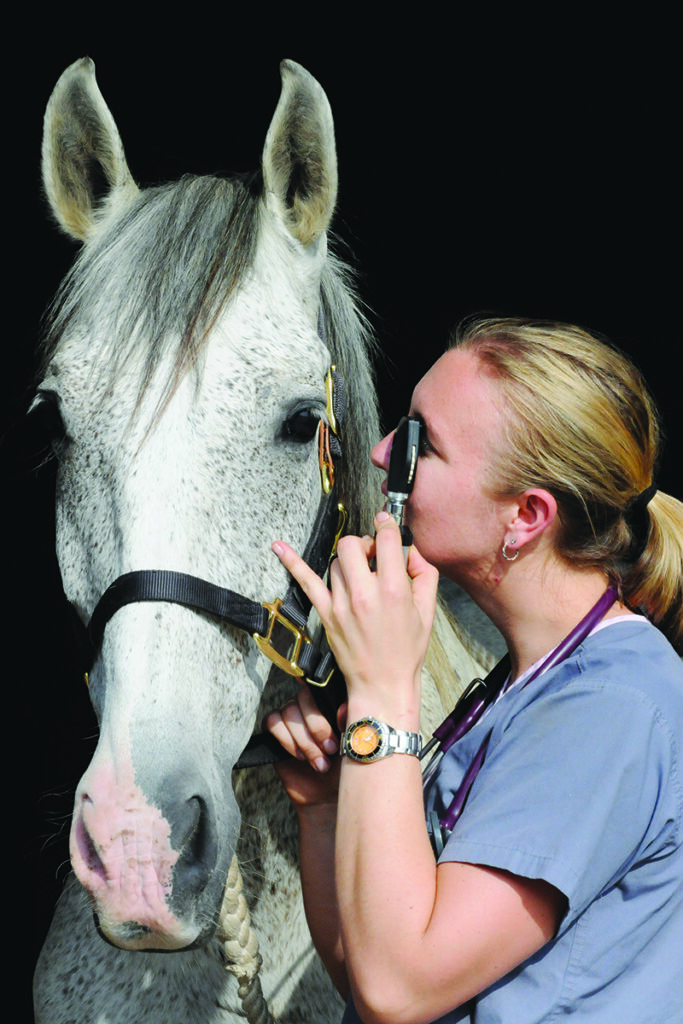
Your horse may become very head shy and not want to face direct light with an eye ulcer. The white conjunctiva around the eye will become inflamed and red, and depending on how long the scratch has been there, there may be a light blue spot on the eyeball itself. This is called corneal edema and is the result of fluid accumulation. If you’ve ever had anything stuck in your eye, you can easily understand how painful a corneal ulcer is.
What to Do
When finding your horse with an eye injury or an eye ulcer, the first thing you should do is call the vet. Never “wait and see” with a suspected corneal ulcer. If something is continually rubbing the eye or stuck, this can deepen the ulcer and put the horse in danger of ocular rupture. Also, the longer an ulcer goes without treatment, the more susceptible it is to secondary infection, which vastly complicates healing.
As you wait for your vet to arrive, place him in a dark stall with a fly mask, if you have one. It’s best to avoid flushing or washing the eye until your vet examines your horse, in case a foreign object is still in or around the eye.
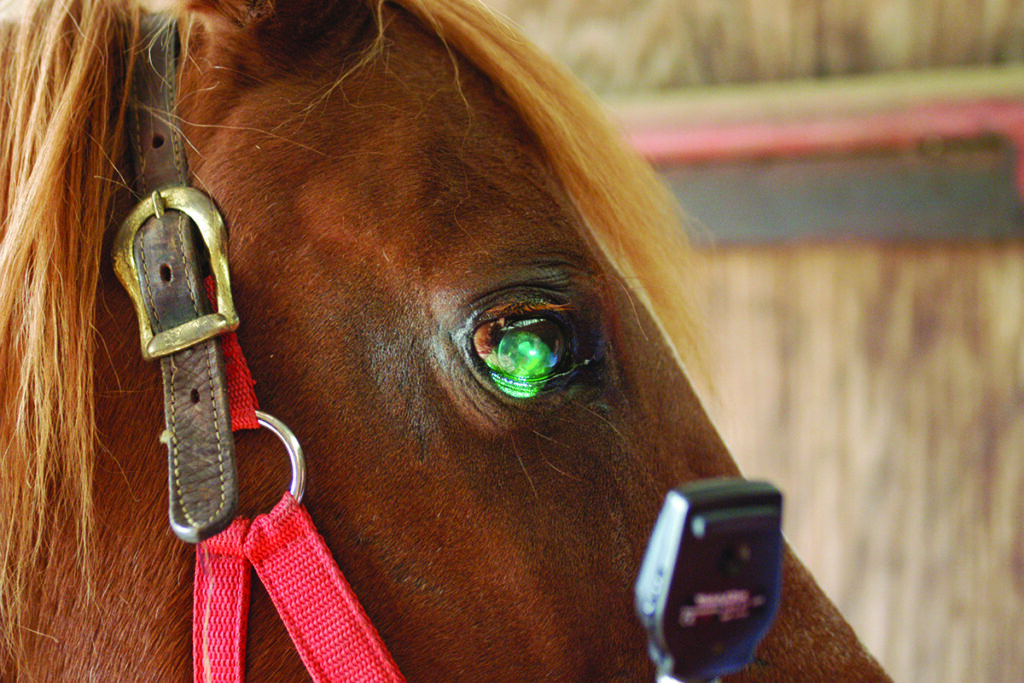
When your vet arrives, she will likely sedate your horse and do a nerve block to the upper eyelid, which allows for a safe, comfortable, and thorough examination of the eye. She’ll then flush the eye with sterile saline and apply a fluorescein stain.
This stain is a simple, yet fantastic, diagnostic tool; this special temporary dye adheres only to the middle layers of a damaged cornea, thereby allowing your vet to immediately see whether or not the corneal epithelium has been breached and an ulcer is present. Ulcerated corneal tissue shows up as a bright, neon green.
Depending on the extent of the damage, your vet may also use an ophthalmoscope (a special handheld lens and light tool) to examine the inner structures of the eye; however, the inner eye can be hard to see with corneal edema, which makes the cornea a cloudy, opaque bluish color.
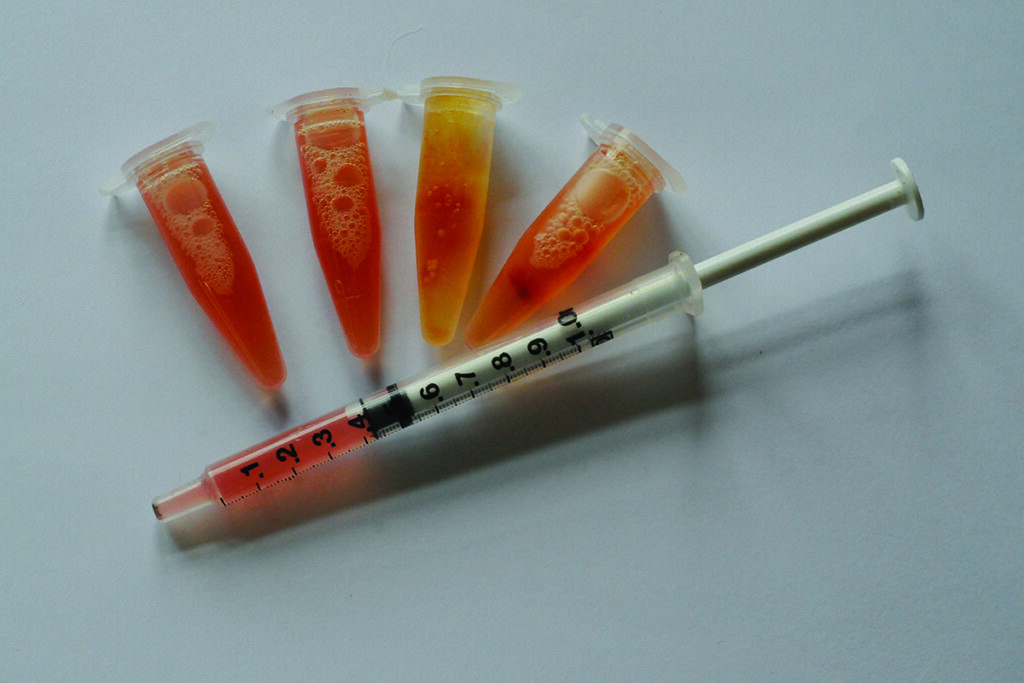
Treatment for an Equine Eye Ulcer
Once your vet diagnoses a corneal ulcer (and any other damage or disease is ruled out), treatment can begin. Equine eye ulcer treatment consists of two primary components: pain control and wound healing.
For pain control, your vet may prescribe a non-steroidal anti-inflammatory drug, such as flunixin meglumine (Banamine) or phenylbutazone (bute). A drug called atropine, usually given as an eye ointment, is also sometimes prescribed for eye pain. Atropine makes the eye muscles relax, along with dilating the pupil. For this reason, horses on atropine should be kept out of direct light.
Wound treatment typically includes a triple antibiotic ointment. When applying, hold the ointment tube parallel to the lower eyelid and squirt a ribbon along the inside of the lid. Blinking action will ensure the antibiotic covers the eyeball. Never direct the end of the tube at the eyeball itself (perpendicularly); you could accidentally poke the horse in the eye if he suddenly moves. Applied three or more times a day, this ointment helps prevent secondary bacterial infection and gives the eyeball a protective, moist covering. The cornea is remarkably resilient and can heal quickly. Superficial equine eye ulcers frequently heal within three to seven days.
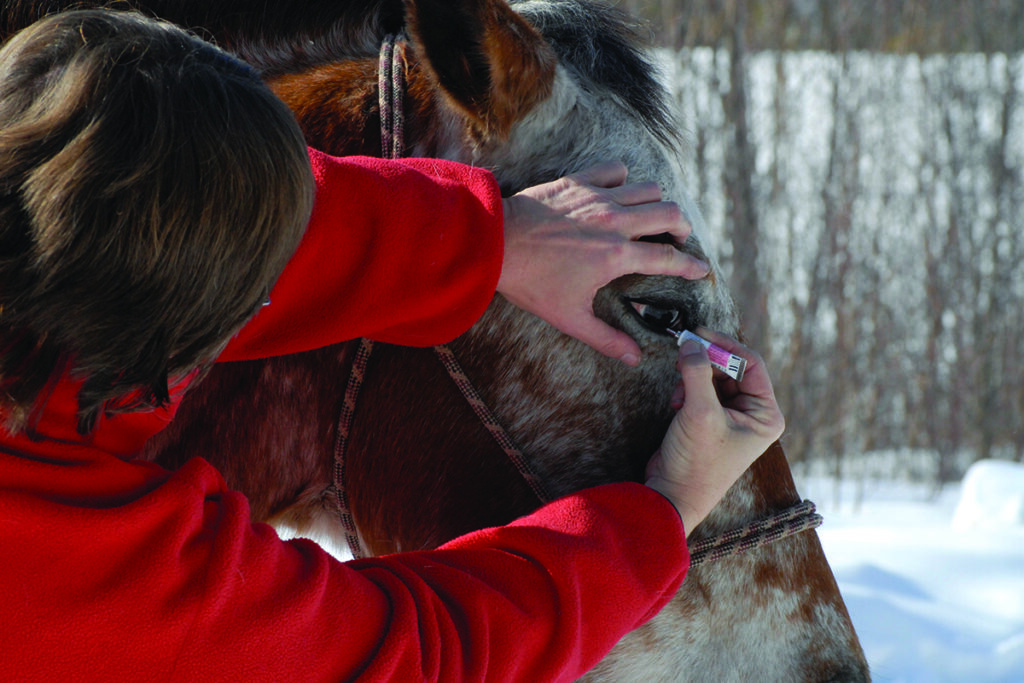
One other unique medical treatment is autologous serum. Interestingly, some studies have shown that administering a horse’s own blood serum to the eye further encourages corneal healing. Your veterinarian may draw a tube or two of your horse’s blood and give you vials containing the serum if she assesses that this will help.
Sometimes, depending on the extent of the ulcer and the horse’s temperament, it can be challenging to safely administer medications in the eye multiple times a day. If your horse is resistant to repeated application of an eye ointment, a sub-palpebral lavage system may be set up.
This system uses a soft, flexible catheter inserted in the upper eyelid. Thin tubing is then extended back along the horse’s neck, so the handler can be away from the horse’s head and deliver the medication without upsetting him. This system is very handy, but it requires a horse to be stall-bound during healing and watched closely.
Horses requiring a sub-palpebral lavage system should be hospitalized for adequate observation and management. If you’re having problems administering your horse’s medications, let your veterinarian know right away.
For uncomplicated equine eye ulcers, treatment typically extends for a week or two. During this time, keep a fly mask on your horse and make sure he has the ability to stay out of the sun. For the first few days, it may be beneficial to keep your horse in a dim stall. As the eye heals, you will see the cornea clear up and the horse will experience less pain.
Complications
Depending on the depth of the equine’s eye ulcer, the inciting cause, and how long it took to initiate treatment, this condition can become infected or deepen. Bacteria and fungi can easily invade a damaged cornea.
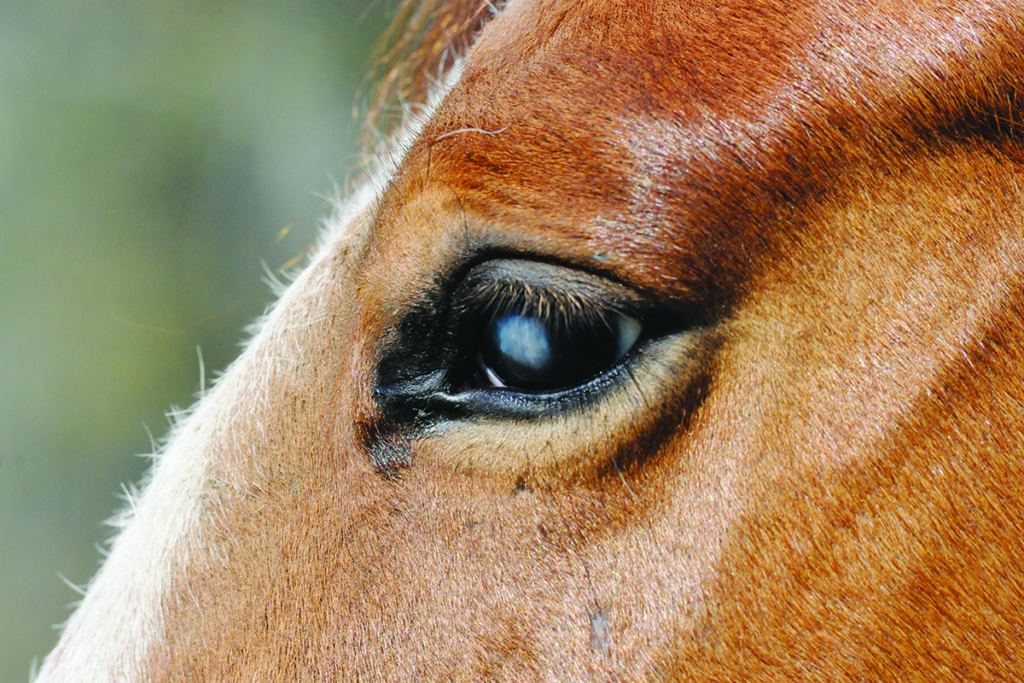
When this happens, the ulcer won’t heal, and it is called an indolent ulcer. In these cases, topical medications may not be strong enough. Either systemic drugs will need to be prescribed, or in some circumstances, a horse may become a candidate for eye surgery.
Corneal stromal abscesses occur when a bacterial infection seeds within the corneal tissue, and these sometimes need to be scraped away. Secondary infections within the eye tissue can be stubborn and may require referral to an equine ophthalmologist for further evaluation and management.
Depending on how large and deep the equine eye ulcer is, a scar may result. These typically don’t impinge on a horse’s eyesight to a great extent but do appear as a permanent white mark on the surface of the eye.
Preventing an Eye Ulcer
Corneal ulcers in horses are typically accidental, so they can be hard to prevent. However, there are a couple good practices to keep in mind.
First, try to avoid having any hooks or sharp points in the stall. This includes handles on water buckets and hooks for hanging halters. Second, keep fences in good repair and remove broken tree branches when necessary. This also helps prevent those annoying scrapes and nicks that plague our horses at any time of year.
Warning!One vital note on what not to give: A horse with an eye ulcer should never be given steroids. Although steroids like dexamethasone are great at reducing inflammation and helping with pain (and are used for some other eye conditions), they inhibit the delicate cellular healing process and impede the horse’s immune system, making him more susceptible to secondary infections. For these reasons, it’s important to not use just any old tube of ointment on a new eye wound; some antibiotic ointments also contain a steroid and therefore shouldn’t be given when an ulcer is suspected. |
This article about equine eye ulcers originally appeared in the August 2021 issue of Horse Illustrated magazine. Click here to subscribe!






